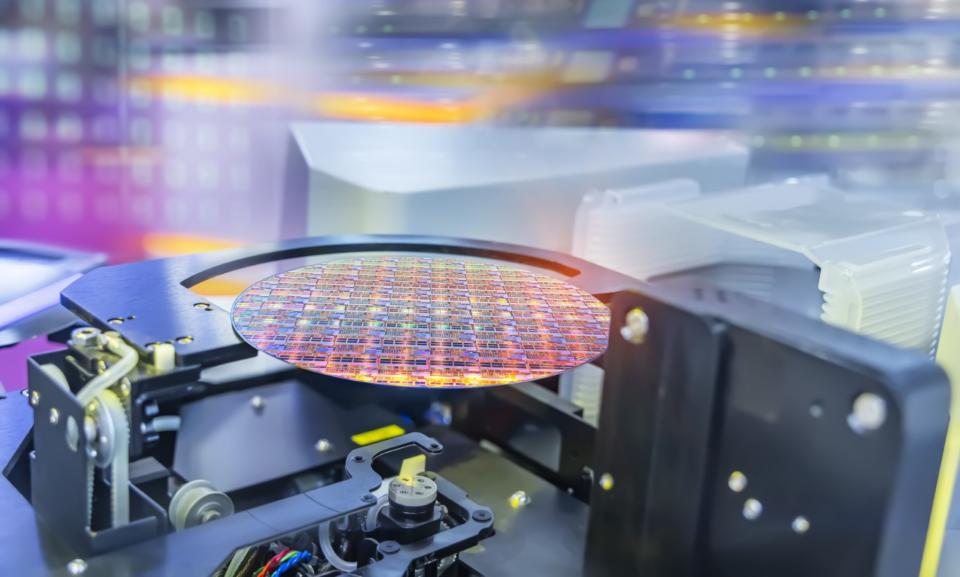
Advanced Micro Devices (NASDAQ: AMD) gave up on manufacturing its own chips back in 2009. It was the right call — AMD couldn’t afford the mammoth outlays required to keep its fabs competitive with Intel (NASDAQ: INTC). While this move allowed AMD to focus on chip design while tapping manufacturing services from third-party foundries, Intel’s manufacturing tech was the best in the industry until recently.
Starting about five years ago, long delays and missteps by Intel related to its troubled 10-nanometer (nm) process node allowed AMD to flip the script. Taiwan Semiconductor Manufacturing Company (TSMC), which AMD uses for manufacturing, now offers more advanced process nodes than Intel has been able to muster. AMD’s PC and server central processing units (CPUs) have had the advantage of superior manufacturing for the past few generations, helping the company win considerable market share.
Intel is still the market leader, but AMD now claims about 20% of the PC CPU market and nearly 24% of the server CPU market. Progress in the server CPU market has been particularly impressive — AMD’s market share stood at just 0.8% at the end of 2017.
Staging a manufacturing comeback
Intel has had to make do with its inferior manufacturing technology, but the situation is set to change later this year. The company is doing two things that will effectively erase AMD’s manufacturing edge.
First, Intel has become more open to outsourcing to TSMC for manufacturing. The company will use TSMC’s advanced 3nm process for the main compute tile in its Lunar Lake laptop CPUs, ensuring that the chips deliver the performance and efficiency gains Intel is targeting. This is the same process node that AMD is using for its upcoming Ryzen AI laptop chips, which will launch later this month.
Second, Intel is full steam ahead on its plan to become the world’s second-largest foundry by 2030. The company has launched products on its Intel 4 and Intel 3 process nodes, but neither can match TSMC’s best. Intel 20A, which Intel will use for this year’s Arrow Lake desktop CPUs, and Intel 18A, which will be ready early next year, are expected to close the gap. Panther Lake, expected to launch sometime in 2025, will use the Intel 18A process.
Even if Intel only matches TSMC in manufacturing, AMD’s manufacturing edge will be a thing of the past.
More competition is coming
Intel and AMD have formed a duopoly in the PC CPU market for many years. That’s now changing as Microsoft embraces Arm-based CPUs for Windows laptops. Capable devices powered by Qualcomm chips are on the market, and more CPU designers are likely to join the fray.
For AMD, this competition is all downside. For Intel, there’s downside but also upside. Intel is working with Arm to optimize its Intel 18A process for Arm-based chips, so the company could end up manufacturing some of those competing PC CPUs down the road, especially if it can pull ahead of TSMC technologically.
With AMD’s manufacturing edge over Intel set to vanish and an increase in competition looming, the company may have a tough time maintaining its market share gains in 2025 and beyond.
Should you invest $1,000 in Advanced Micro Devices right now?
Before you buy stock in Advanced Micro Devices, consider this:
The Motley Fool Stock Advisor analyst team just identified what they believe are the 10 best stocks for investors to buy now… and Advanced Micro Devices wasn’t one of them. The 10 stocks that made the cut could produce monster returns in the coming years.
Consider when Nvidia made this list on April 15, 2005… if you invested $1,000 at the time of our recommendation, you’d have $771,034!*
Stock Advisor provides investors with an easy-to-follow blueprint for success, including guidance on building a portfolio, regular updates from analysts, and two new stock picks each month. The Stock Advisor service has more than quadrupled the return of S&P 500 since 2002*.
*Stock Advisor returns as of July 2, 2024
Timothy Green has positions in Intel. The Motley Fool has positions in and recommends Advanced Micro Devices, Microsoft, Qualcomm, and Taiwan Semiconductor Manufacturing. The Motley Fool recommends Intel and recommends the following options: long January 2025 $45 calls on Intel, long January 2026 $395 calls on Microsoft, short August 2024 $35 calls on Intel, and short January 2026 $405 calls on Microsoft. The Motley Fool has a disclosure policy.
AMD’s Key Advantage Over Intel Is Set to Vanish was originally published by The Motley Fool
EMEA Tribune is not involved in this news article, it is taken from our partners and or from the News Agencies. Copyright and Credit go to the News Agencies, email news@emeatribune.com Follow our WhatsApp verified Channel





